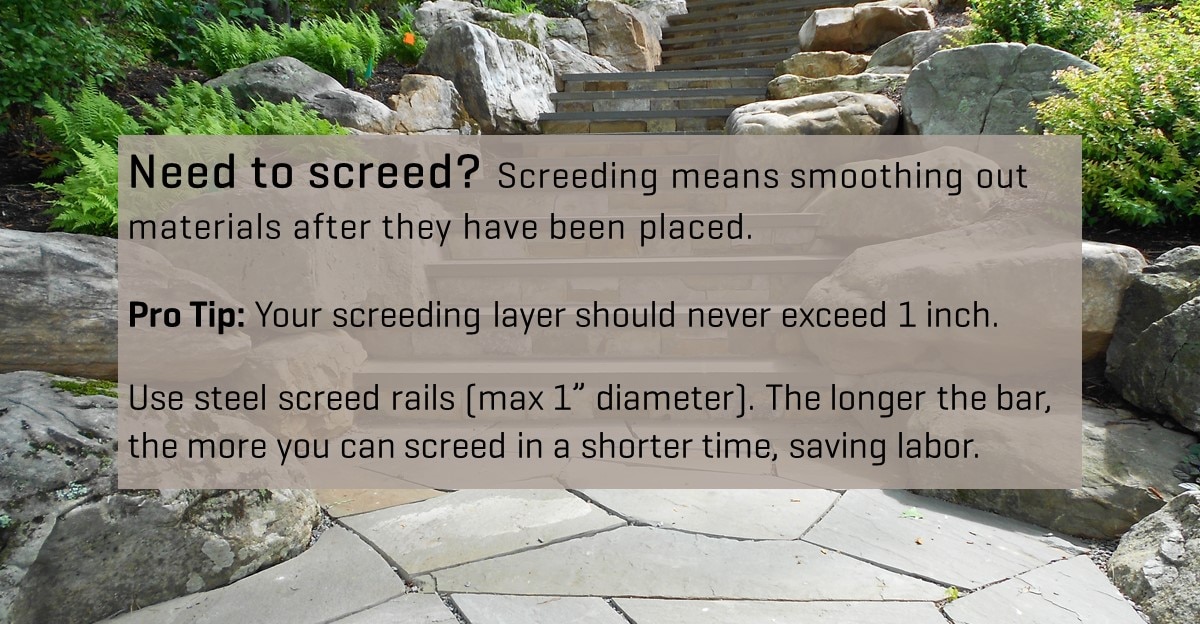Efficiency Tools for Hardscaping Jobs
If you’re just starting out in hardscapes or need a refresher on helpful tools for the jobsite, take a look at this list of our favorite tools.
September 14, 2023

Time is money, and you want to be as prepared as possible for a wide variety of jobs. These tools are a great starting point in the hardscaping business and are needed at most job sites. You probably already own some of them.
Personal Protective Equipment (PPE)
You need PPE before you begin. Plan for the best and expect the worst.
Steel toe boots are necessary to protect your feet from heavy materials on the jobsite. Make sure every team member has a pair of safety glasses when cutting and chiseling to protect eyes from debris. Cutting pavers, slabs, and stone with power tools can cause hearing damage, so don’t forget ear protection. See our Ear Protection Tips video for more information. Crew members should wear dust masks in order to be compliant with OSHA standards and to prevent lung damage. Your hands are your livelihood. Work gloves go a long way to protect some of your most important tools.
Essential Hardscaping Tools
Hand tools
- Tape measure
- Helps in ordering product, providing a quote, checking heights/widths when installing
- Multiple recommended, as several crew members should have them
- Marking pencil
- Mark lines as needed throughout the project
- String line
- Creates a border marking for your project
- Also helps determine the slope of the project
- Creates straight line to lay pavers on, or a level line to build a retaining wall to a specific height
- String collar
- Quickly adjusts the height of your string line and provides a base for multiple string runs
- Spikes and stakes
- Required to hold string line and later edging in place
- Shovel
- Need to dig on every project, pointed necessary, flat head can be a good add
- Rake
- 16” metal rake for spreading mounds of gravel and 36” landscaping rake for screed over larger area
- Also ensure you have a Screeding rake
- Levels the bedding layer and allows you to screed a wider area, reduces time spent on job, some have adjustable handles for different lengths
- Hand tamp
- Useful for hard-to-reach areas and along edges – steel handle is recommended (wood breaks)
- Adjustable hose nozzle
- Helps water in polymeric sand
- Levels
- Should have multiple sizes for different job needs
- The larger the level, the less time spent moving and re-leveling
- Use a transit or laser level for the highest accuracy
- Aluminum Screed
- Used to smooth materials like concrete, stucco, and plaster after they have been laid down to help flatten the surface

- Hammer
- Hammering in nails, can also use on chisel when creating rock faces
- Dead blow hammer
- Used for paver adjustments and leveling pavers or wall units
- Chisel
- Necessary when creating rock face on wall block
- Rubber mallet
- Necessary for first layer of retaining wall and to make sure blocks are level in every direction (requires force)
- Steel mallets may chip or break blocks
- Caulking gun
- Helpful when gluing top course, coping, or capping wall
- Push broom
- Installing polymeric sand into interlocking joints, medium bristle recommended, hard to rough required, soft won’t sufficiently push sand
- Clamps
- Adjustable clamps save time and labor by allowing you to lift slabs, steps, or wall blocks into place
- Available in different sizes and shapes
Larger Tools
- Speed square or paver square
- Helps find accurate 45˚ and 90˚ angles instead of using a small square or measuring tape
- Leaf blower
- Cleans excess polymeric sand and other debris from the project surface so the materials do not stick and harden
- Wheelbarrow
- For transporting materials
- Paver lifting tool
- Allows you to move many pavers at once, saving time on installation
- Paver extractor
- Very helpful when there is a broken stone or paver
- How it works: Set size of clamp, place teeth in joints of stone you want to remove, use mallet to hammer teeth into joints, lift handle jiggling to remove paver
- Paver adjuster
- Helps adjust difficult lines, has flat edge to push several pavers, use mallet part of tool to hit stubborn pieces into place
- Cut off (or demo) saw
- Used to cut curbstones, pavers, concrete, and more
- Creates the perfect lines customers look for in their hardscaping
- Plate compactor
- Exerts force on the ground and vibrates rapidly, compacting the soil and eliminating air pockets
- Provides better compaction of materials
SiteOne’s Castle Collection
SiteOne has developed a comprehensive natural stone solution for beautiful outdoor spaces that saves you time and money. Jumbo-sized, natural paving stones come in convenient patio packs of 108 square feet to reduce expenses and project waste while keeping your jobsite neat. All the stones in this collection have a milled bottom surface with a gauged tolerance of +/-4mm. This consistent thickness makes installation easier and faster compared to traditional natural stone products. The Castle Collection provides you with seamless solutions to complete your entire project. From patio flooring to coordinating finishing pieces, this collection is perfect for any project, big or small.
SiteOne Stone Centers are Your One-Stop Shop
Whether you need products or have questions about a job, SiteOne Stone Center associates are ready to help at your local branch. You can also shop at SiteOne.com or the SiteOne mobile app.


